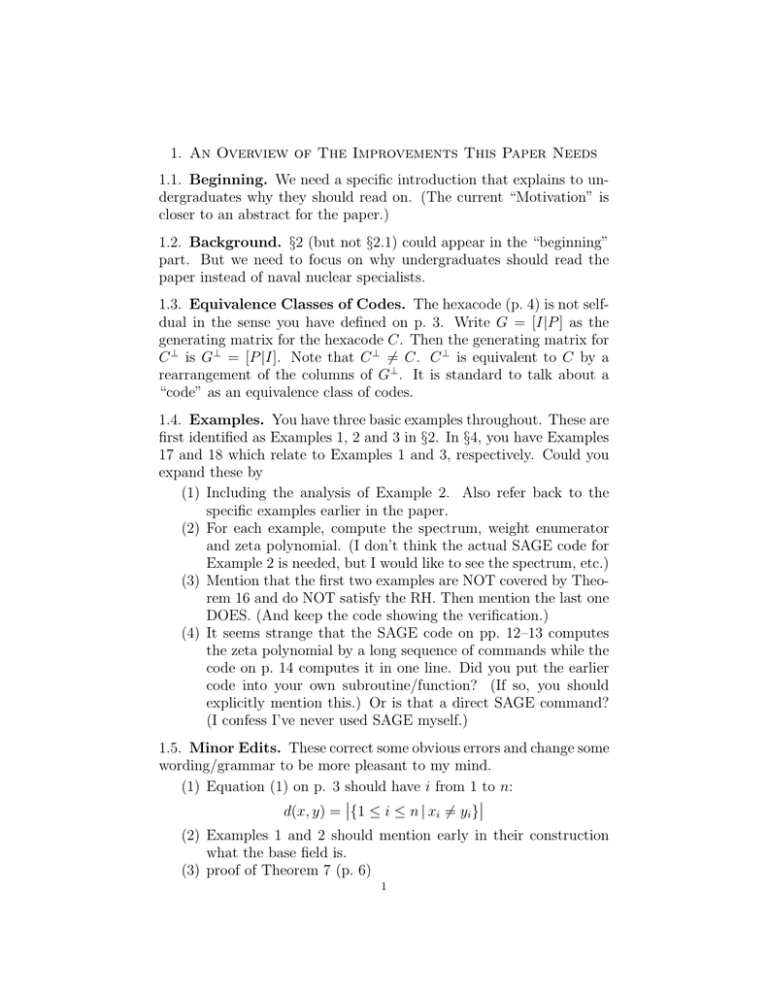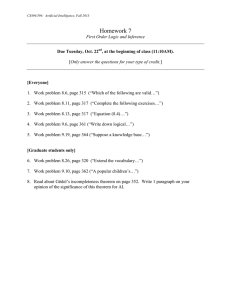1. An Overview of The Improvements This Paper Needs
advertisement

1. An Overview of The Improvements This Paper Needs
1.1. Beginning. We need a specific introduction that explains to undergraduates why they should read on. (The current “Motivation” is
closer to an abstract for the paper.)
1.2. Background. §2 (but not §2.1) could appear in the “beginning”
part. But we need to focus on why undergraduates should read the
paper instead of naval nuclear specialists.
1.3. Equivalence Classes of Codes. The hexacode (p. 4) is not selfdual in the sense you have defined on p. 3. Write G = [I|P ] as the
generating matrix for the hexacode C. Then the generating matrix for
C ⊥ is G⊥ = [P |I]. Note that C ⊥ 6= C. C ⊥ is equivalent to C by a
rearrangement of the columns of G⊥ . It is standard to talk about a
“code” as an equivalence class of codes.
1.4. Examples. You have three basic examples throughout. These are
first identified as Examples 1, 2 and 3 in §2. In §4, you have Examples
17 and 18 which relate to Examples 1 and 3, respectively. Could you
expand these by
(1) Including the analysis of Example 2. Also refer back to the
specific examples earlier in the paper.
(2) For each example, compute the spectrum, weight enumerator
and zeta polynomial. (I don’t think the actual SAGE code for
Example 2 is needed, but I would like to see the spectrum, etc.)
(3) Mention that the first two examples are NOT covered by Theorem 16 and do NOT satisfy the RH. Then mention the last one
DOES. (And keep the code showing the verification.)
(4) It seems strange that the SAGE code on pp. 12–13 computes
the zeta polynomial by a long sequence of commands while the
code on p. 14 computes it in one line. Did you put the earlier
code into your own subroutine/function? (If so, you should
explicitly mention this.) Or is that a direct SAGE command?
(I confess I’ve never used SAGE myself.)
1.5. Minor Edits. These correct some obvious errors and change some
wording/grammar to be more pleasant to my mind.
(1) Equation (1) on p. 3 should have i from 1 to n:
d(x, y) = {1 ≤ i ≤ n | xi 6= yi }
(2) Examples 1 and 2 should mention early in their construction
what the base field is.
(3) proof of Theorem 7 (p. 6)
1
2
(a) Delete the first word “Now”
(b) Last line on p. 6 should have a capital “C” as the subscript:
AC (1 + z, 1 − z) instead of Ac (1 + z, 1 − z)
(c) p 7, second line of text: “Replacing” instead of “Replace”
(d) The equation just below “Replace” edit should read
AC (1 + y/x, 1 − y/x) = 2k · AC ⊥ (1, y/x)
(4)
(5)
(6)
(7)
(8)
(9)
(10)
.
(e) The final sentence: AC and AC ⊥ are rational functions,
not polynomials. After multiplying both sides by xn , you
get homogeneous polynomials of the same degree AND the
theorem.
The last equation before §3 should have large parentheses where
applicable. And the concluding statement q = 2 is unnecessarily
restrictive. (The formula is needed as written later in the paper
for general q.) ALSO, you may wish to give this equation a
number as you can use it later.
Definition 8, p. 7, I would write “over F = GF (q)”. But definitely drop the period after “genus”.
After the definition of b-divisible (p. 8), I would mention that
the most common usage of virtual weight enumerators is the
case of actual weight enumerators. (It is not known how to
determine if a particular virtual weight enumerator with nonnegative integer coefficients is an actual weight enumerator of
an actual code. Thus, we enlarge the class of polynomials we
look at.)
First line after Theorem 9 (p. 8): the apostrophe is pointing in
the wrong direction.
Definition 12 (p. 9) needs considerable work.
(a) Mention P (T ) has coefficients in C.
(b) The degree of P (T ) is “at most n − d” instead of “n + 2 −
d − d⊥ ”. (This doesn’t hurt you later and right now you’ve
only got n and d.)
(c) Mention that the right-hand side of the equation is just
the Taylor series expansion (about T = 0) of the left-hand
side.
Between Definition 12 and Proposition 13 (p. 8), you need to
define F ⊥ and d⊥ . See p. 11 and the edit mentioned.
Proof of Proposition 13 (p. 10): Again P (T ) has degree at most
n − d instead of n + 2 − d − d⊥ .
3
(11) Definition of Z(T ) (p. 10). Refer to F (x, y) instead of AC in
the definition. Perhaps reiterate that the most common usage
is when F (x, y) = AC (x, y) for some code C.
(12) Top of p. 11. The analogy to Riemann’s zeta function is indirect. Z(T ) is much closer to the zeta function of a curve defined
over a finite field.1
(13) Definition of F ⊥ (p. 11). This is basically copying Duursma.
There’s nothing wrong,
Youcould amplify this by writ per se.
1 q−1
x
ing σ(x, y) = q −1/2
. ALTERNATIVELY, you
1 −1
y
could define F ⊥ as satisfying the MacWilliams identity just before §3. (This is more “natural” in my mind.)
(14) Proposition 14 (p. 11)
(a) Use big parentheses when appropriate.
(b) “g” is the genus, which you called γ earlier. Please use γ
here.
(15) Ultraspherical polynomials (p. 11).
(a) Your phrasing could be read that Duursma defined these.
Please clarify. You might also mention some authors call
these Gegenbauer polynomials.
(b) You use both Cnm (cos θ) and Cnm (x). (The latter in the
proof of Theorem 16.) So you should probably include
both formulations. (Use one as a definition and the other
as a theorem.)
(16) Theorem 15 (p. 12)
(a) With your presentation, there’s no need to introduce Duursma’s Q(T ) directly in the statement of the theorem.
Perhaps use a footnote?
(b) In the formula, use big parentheses where appropriate.
(c) “Where” is not capitalized.
(17) Proof of Theorem 16 (p. 12).
(a) This is the only place in the paper where you are using
complex analysis. To be clear to other undergraduates,
I would mention that the substitution T = eiθ initially
allows θ to be any complex number. But the zeros of the
right-hand side of the equation ONLY occur when θ is real.
1The
zeta function of a curve over F is due to André Weil.
See
A Classical Introduction to Modern Number Theory by Ireland and Rosen or
The Arithmetic of Elliptic Curves by Silverman for a brief introduction to this area.
The analogy is far too long to include in this paper.
4
Hence, the zeros of P (T ) only occur when θ is real. And
|e2iθ /2| = 1/2 is the RH.
(b) The sentence “According to Duursma, all other Type IV....”
is trivial, and you’re not using it. (Trivial: The length
of the code is n = 3m + j for some m ≥ 0 and some
j ∈ {1, 2, 3}. j = 3 is Theorem 15 which is used to prove
Theorem 16. j = 1, 2 are the other cases.)
(18) Example 17 (p. 17). It’s “minimum”, not “minium”.



